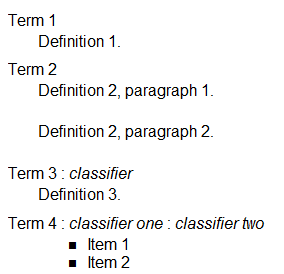Definition list
A definition list describes a list of definitions. Each entry in a definition list contains a term, a definition and optionally classifiers.
Definition lists can be used in different ways:
- As a dictionary or glossary. The term is the word itself, a classifier can be used to identify the use of the term (noun, verb etc.), followed by the definition.
- For describing program variables. The term is the variable name. A classifier can be used to specify the type of variable (string, integer etc.), and the definition describes how the variables are used in the program.
Properties
- A term is a simple one-line word or phrase.
- A definition is a block that is indented relative to the term (the minimum indentation is one space) and can contain several paragraphs and other body elements.
- Optional classifiers can follow the term on the same line, each after a"
:" (space, colon, space).
Principle
+--------------------------+
|term[" : "classifier]* |
+----+---------------------+
|definition |
|(body elements) |
+---------------------+
Sample
The sample shows a definition list with terms, classifiers and definitions.
(In sample project: B_DocuElements\Lists\FB_Libdoc_DefinitionList)
- Further text body elements are used within the definition list (paragraph, unordered list items).
- There must not be a blank line between a term line and a definition block (this distinguishes definition lists from block quotes).
- Blank lines are required before the first and after the last list item of the definition list, but can also be inserted between them.
(*
Term 1
Definition 1.
Term 2
Definition 2, paragraph 1.
Definition 2, paragraph 2.
Term 3 : classifier
Definition 3.
Term 4 : classifier one : classifier two
- Item 1
- Item 2
*)
|
